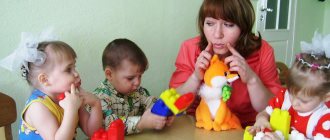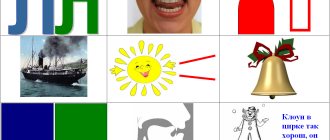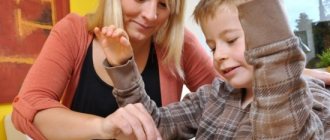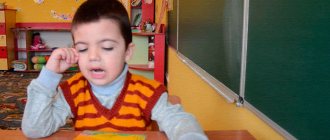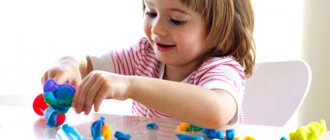Characteristics of a child with ASD
Characteristics of a preschooler with autism spectrum disorder (ASD)
Characteristics of a pupil of MBDOU Kindergarten No. 12 Sofia Igorevna P. (date of birth: December 27, 2012).
Sofia attends kindergarten on September 8, 2014. The girl willingly goes to kindergarten and rarely gets sick. Sofia has difficulty falling asleep during the day, but her sleep is calm and long.
Can eat independently using a spoon and drink from a cup. Sometimes he can take food with his hand from another child's plate. Subject to full supervision and accompaniment of an adult, wipes hands with a towel and uses soap. During the day he does not show any desire to maintain neatness on his own.
By the age of three, Sofia had partially learned to use the toilet: she practically controls the process of urination on her own, but the process of defecation occurs involuntarily. Joint play activities with adults do not last long and contain a small list of manipulations with substitute objects.
For example, in a role-playing game with an adult, “Let’s treat the doll to tea,” Sofia approaches the players for a few seconds, takes a cup and performs a simple action with it, then immediately moves away and completely switches to another type of activity.
Playful activities with children are more of an observational nature; sometimes he can take a toy from another child and run away with it. Sofia can perform joint play manipulations with her peers only with the help of an adult. For example, the teacher offers to build a road from a bright construction set in a joint activity, asks Sofia to submit a Lego construction piece.
Sofia gives the teacher the part. If an attempt to connect two parts fails, he categorically refuses to carry out the action proposed by the teacher, but continues to supply the designer parts, applying them to each other, thereby trying to continue the journey in length.
She loves to play with clothespins in the “Make a Flower” game, but when working with clothespins she does not strive to fulfill the didactic task of selecting objects by color; she is more interested in chaotic actions with them: attach them randomly around the perimeter of the box and, when completed, remove and put them back in box, then put clothespins on the fingers of one hand, then remove and put them back into the box, putting it back in place. A girl can repeat such play manipulations 4 to 6 times during the day.
Any attempts to determine Sofia’s knowledge about color, shape, size using other didactic material end in failure, that is, when asked by an adult to present an object with a certain characteristic, the girl usually hands over the object without determining whether it belongs to a certain characteristic. An adult's insistence on the correct fulfillment of a request causes irritation and dissatisfaction in the child.
The girl willingly takes the initiative in communicating with all adults and even with those who do not constantly work in the group: a nurse, a manager, a deputy manager - she can hang or climb onto an adult’s lap, looking into the eyes and trying to tell something.
Sometimes he shows interest in joint educational activities with adults and children, but only if bright unfamiliar attributes or especially brightly colored emotional moments are used in the lesson. For example, during a music lesson, the teacher used bright rattles, Sofia, interested in the sounding toys, briefly joins in the joint activity and repeats the simple movements demonstrated by adults (running, spinning), but at the end of the musical-rhythmic movements in the exercise “hid the toys” Sofia no longer takes part , but continues to perform the actions she likes with rattles.
Parents about autism in children
Childhood autism syndrome.
Myths about autism. There are certain myths about autism:
- Autism is gifted, non-standard, with outstanding abilities. No. (20% of autistic people have intact intelligence. The remaining 80% have intellectual disability).
- Autism can be cured - it's a myth. It cannot be cured. People are born and die with it. Autism is incurable.
- An autist is a person who is in a shell. And this shell can be removed and there will be a normal person. It will not happen. Autism is a perennial disorder. Something is deeply broken and all systems are broken.
- Moms are refrigerators. This is also incorrect. Autism is biological in nature, children are born with it
Causes of autism:
- Genetic predisposition.
90% of autism is genetically determined (but not a hereditary disease) i.e. one of the relatives may have conditioned behavior (there is a gene that is a carrier and can fully manifest itself in some generation).
- Organic damage to the central nervous system.
Boys are more likely to suffer from autism than girls – previously the ratio was 4:1, now it is 5:1.
An autistic child's brain is larger than a typical child's. Characteristics of children with autism Autism is a distorted mental development.
1. Symptoms of autism: - Autism - avoidance of contact or lack thereof. Noticeable at an early age. It manifests itself most clearly between the ages of 3 and 5 (understands everything, but does not speak, avoids contact, does not play with children). — Fixes his gaze strangely. (does not fix his gaze on the face, or quickly looks away, often looks but does not see).
A child with autism completely ignores everyone, fixes his gaze on specks of dust, water, etc.
— The first smile appears on time, but is not addressed to anyone in particular (a smile to a toy, a sofa, an adult, a mother - the same).
There is no complex of revival when a close adult appears. — The child does not ask to be held.
Anyone can take it. Doesn't respond to affection. Doesn’t choose a comfortable position on his hands - remains tense as a pebble. — Sluggishly displays a posture of readiness.
Many children have a positive attitude towards affection, but become fed up very quickly. - They react in a peculiar way when the mother leaves the room (no reaction or a strong, pronounced reaction - hysteria, which cannot be stopped.). - Lack of adequate contact with children in the 2nd year of life or take an active part in games without rules (running around, running around), can examine children (nose, eyes).
We recommend reading: Spain same-sex marriage
— Violation of differentiation: living - nonliving is a manifestation of autism. 2. The phenomenon of identity is the child’s desire to maintain the same situation, constancy.
External signs: aggression, stereotypy (multiple repetition of the same thing). With autism, children are caught up in stereotypy (jumping, swaying, shaking near the eyes, running against the wall watching their shadow, twisting threads, licking, sniffing things unsuitable for this, pronouncing affectively significant phrases when telling a story - it’s difficult to break from this.) A habit of eating is noted. , music, game - the same thing many, many times.
Preview:
Characteristics of a child with RDA.
The boy attends a short-term group for children with disabilities where he receives psychological and pedagogical support from the following specialists: a speech pathologist, a speech therapist, a social worker, and an additional education teacher. The basis for enrollment in the group is the direction of the OMPK. Conclusion of the OMPK: specific systemic underdevelopment of speech, a variant of distorted development with severe communication impairments, impaired cognitive activity against the background of distorted development.
The child is brought up in a complete family, neat in appearance, well-groomed.
Adaptation to the conditions of stay in an educational institution is difficult: there is crying before the start of classes, reluctance to enter specialists’ offices, regression of neatness skills.
There is no distress when parting with parents.
Level of current development. Establishes communication with adults for an extremely short period. Visual contact is unstable. He does not avoid tactile contact; he often initiates it.
Does not communicate with peers. He ignores attempts by peers to involve him in joint play.
Independent play is reduced to stereotypical actions with toys; play actions are monotonous and poor. Uses an objective method to solve game problems. Game actions are not emotionally colored, role-playing statements are not available.
Cognitive development. There is a pronounced developmental dissonance: the skill of reading words and uncommon sentences fluently has been developed; familiar with numbers, the number series (within the first ten) is laid out in the correct sequence. Instructions offered in written form are more readily followed than verbal ones.
Completes the proposed tasks extremely selectively. When the teacher tries to involve him in solving a given cognitive task, if the slightest difficulty arises, he shows negative reactions: he screams, throws toys, tries to break, tear up manuals, and episodes of auto-aggression are noted.
Accepts a one-step instruction and holds it.
The reaction to encouragement and reprimand on the part of the teacher is not clearly expressed.
Shows no interest in this activity. Weapon actions are not formed. Hand-eye coordination develops at a slow pace.
Speech development. Outwardly does not show understanding of the addressed speech.
In spontaneous speech, various vocalizations and extralaryngeal sound formations are recorded. Spontaneous imitation of various sounds, words and statements is not observed.
No abnormalities in the structure of the articulatory apparatus were identified.
Motor sphere. Motor tone is increased.
Self-care skills are developed at a slow pace. Neatness skills have not been developed.
Signs of an autistic child
: 5 / 5
Until the 90s, this diagnosis was rarely made. Now some psychiatrists believe that it is too common. There is overdiagnosis.
Some children exhibit autistic characteristics, but this does not mean that they have autism. Just that kind of character. Autistic symptoms in this case are temporary and disappear with age.
Signs and symptoms of autism
However, the disease “autism” exists and the diagnosis is made by a medical specialist. In this case, the specialist is a psychiatrist.
Autism is a congenital disorder. It is difficult to identify it at an early age, but a competent specialist will notice the initial signs from about 3 months, and parents from 1.5-2 years. Doctors have special tests to determine the disease.
Signs of autism vary by age. They are divided into 4 groups:
- early autism (in children under 2 years old),
- childhood autism (2-11 years),
- adolescent autism (teenagers 11-18 years old)
- autism in adults.
Symptoms of early autism
Social behavior
- The baby prefers to be alone.
- When addressing him specifically, he does not look him in the eye or looks as if through you.
- Often does not like to be touched.
- Reaction to mother: either does not pay attention, or cannot stand even her short-term absence.
- Does not imitate adults (although by age he should be a “monkey”)
- A child's reactions to various stimuli are unpredictable.
- Selects non-play items as toys: strings, shiny rags, pieces of furniture, etc.
Communication
- The baby either has a speech delay (speaks little, briefly, reluctantly), or we see regression in speech: speech was of acceptable quality, then the child began to speak less and less.
- The baby is not interested in the world around him. He doesn't show curiosity, doesn't ask questions.
- The child never smiles back.
- Doesn't react when asked for something, doesn't keep up the conversation (or does it extremely reluctantly).
- Does not like games with children and adults. Usually alone he manipulates non-game objects.
- Speech contains echolalia, i.e. the child mechanically repeats a phrase he hears. Talks about himself in the third person.
Stereotypic (monotonic) behavior
- Tends to constantly repeat the same simple movements (twist a rope, walk or run in a circle, etc.).
- With great difficulty he gets used to everything new: actions, things, people, places, etc.
- Stick to a daily routine.
- Selective in food, does not know how to chew for a long time.
Children with early childhood autism attend preschool institutions. Below is an example of what their behavior might look like. The characteristics were written for submission to the ITU. You can write a testimonial for TPMPC, ITU, and other organizations using the signs of an autistic child listed above.
Example of characteristics of an autistic child
Psychological and pedagogical characteristics
Last name, first name – date of birth, living at the address ..., visiting ... from (date).
Attends the first junior group (children from 2 to 3 years old). Observed by teachers and a psychologist from the moment of enrollment.
Observation results
It was difficult to adapt. After his mother left, he screamed for a long time. His mother brought his favorite towel, and only by covering his head with it did the boy calm down. He also calms down by circling around himself.
A pedagogical characteristic for a preschooler, ready-made samples of which you will find in this article, is an official document filled out by a kindergarten teacher and certified by the seal and signature of the head of the preschool educational institution.
The data from this document is needed for a psychiatrist, speech therapist, psychiatrist, guardianship authorities and other specialists who take part in a psychological and pedagogical examination.
Characteristics of a child in a preschool educational institution from the teacher
Any characteristic consists of several points that are taken into account when entering school. The teacher gives a complete description of the pupil's family. Describes whether the child likes kindergarten and indicates the reason for absences.
Indicates the level of sociability, independence, temperament, attitude to classes, to work. Which work does he do better, which one does he refuse, and does he complete the job?
Pay attention to behavior during the game, what roles he chooses.
In conclusion, recommendations for parents and teachers are given to the description of the psychological portrait.
How to write a character reference for a child
When compiling, it tells about all the qualities and characteristics of a person. This document must always be present in the child’s card so that when transferring to another kindergarten or school there is an initial idea of the child.
Features of gaming activities
Play is an accessible activity for children. In the game, abilities and capabilities are fully revealed, thinking, emotional state, activity, communication and behavior in society are manifested.
With the help of games, children not only develop, but also go through the process of education. Interests and inclinations are revealed.
Features of the emotional-volitional sphere and personality
This paragraph describes emotions and feelings. How often can your mood change? To which he may react inappropriately. Can he control his actions?
Are there any negative aspects of character? All these qualities are well manifested in society.
Examples and samples of filling out documents
We present examples of writing for a child in a preschool educational institution, which will be needed when drawing up a profile.
Pedagogical characteristics for preschoolers for PMPK
It is needed to pass the commission. You can write in specific points or in any form, it must end with the date, signature of the teacher, director and seal.
First of all, you need to indicate the name of the institution and group. Personal information of the child. Date and place of birth. Information about parents. When did you enter kindergarten, at what age?
Further:
- Write the reason for applying to the PMPK.
This may be developmental delay, difficulties in learning and education.
- Write a few words about the family.
How did you adapt to kindergarten? Pay attention to the reason for absences from the establishment. How he takes part in games and activities.
- Speech development:
at what age did he begin to speak well, what is his vocabulary, and makes sentences based on a picture of one or more words. Participation in conversations. When reading works, are you distracted by other activities? Learns poems by heart, partially or completely.
- Mathematical representations:
ability to count to ten forwards and backwards; does geometric shapes distinguish the left side from the right?
- Game activity:
what games he prefers, whether he uses toys for their intended purpose, and whether he puts the equipment back in its place after playing.
- Visual activities:
whether he confuses colors, whether he is well oriented on a sheet of paper, or whether he draws with pencils or a brush. Does he tidy up his belongings after work? Does it work well with scissors? When sculpting, he confuses the shapes or not.
- Physical development:
Does he actively participate in outdoor games? Is the sense of tempo impaired?
- Independence:
at this age should do some things on his own. Whether or not he notices a sloppy appearance. Does he use a spoon and fork correctly? Whether it helps others or not. How does he react to the teacher’s comments?
- List your basic habits.
- Date, sign and seal.
Characteristics of a child with mental retardation for PMPK
The scheme is the same as for PMPC. But expert opinions are definitely needed: pediatrician, ENT specialist, psychiatrist, neurologist, ophthalmologist.
Talk about psychophysical points of development. Namely: visual perception, auditory attention, memory. Give a general assessment of the degree of educational skills (correspondence of knowledge and skills, requirements).
Speech therapy presentations at schoolchildren’s PMPK
Speech therapy characteristics are important because they rely on speech formation. Here we need to pay attention to the structure of the articulatory apparatus.
Indicate the pronunciation of sounds, describe the defectological characteristics of sounds. What sounds does it confuse, miss, or mix up?
Word structure: reverses syllables, difficulty pronouncing some words. Rearrangement of sounds and syllables.
Speech analysis: how to construct sentences, monosyllabic or well describes what is happening.
Vocabulary is close to age.
At the end of the characteristics, give recommendations to parents.
Characteristics of an autistic child from kindergarten
When writing this type of description, you need to know about the characteristics of the disease. Describe in more detail the capabilities of a child with this disability group.
Autistic people are usually hyperactive and have frequent mood swings. They react very negatively to comments, even to requests.
Therefore, the positive and negative aspects of the minor should be indicated. How he completes tasks. Understanding requests and appeals. What he likes to do most, what buildings to complete.
Dwell in detail on personal characteristics, talk about disturbances of emotions and feelings.
Psychological and pedagogical characteristics of children of senior preschool age and graduates of preschool educational institutions
Preparation for school in kindergarten begins in the preparatory group at the age of 5-6 years.
It differs from other characteristics in that it must be based on cognitive processes: attention, memory, thinking, speech development at the preschooler level, and the formation of educational activities.
Write in detail about verbal qualities. Comprehension of the text read, the presence of stuttering, whether there are any problems with the pronunciation of sounds. Ability to maintain dialogue.
What correctional work was carried out with preschoolers and parents to solve difficult moments in personality formation. Result and further recommendations for teachers.
Conclusion
When compiling characteristics, the individual characteristics of each child are taken into account. Don't forget about age categories (3-4 years, 4-5 years).
There are times when a brief description is needed. In this case, it can be compiled according to a simple scheme.
In any text of the characteristics, do not forget to write about awards and participation in competitions. Indeed, today even children with cerebral palsy can express themselves in various competitions, festivals and quizzes.
